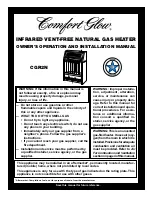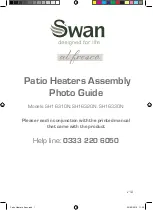
7
GENEVA
UNVENTED WATER HEATER
4.4. Temperature and pressure relief valve
The temperature and pressure relief valve (T/P Valve) is supplied (Figure 2). Once the T/P
valve is fitted it should not be removed from the cylinder or tampered with in any way. The
valve is pre calibrated to lift at 0.7 MPa or 90oC and any attempt to adjust it will render the
guarantee null and void and could affect the safety performance of the unit.
The outlet of the T/P valve should be routed in 15 mm copper piping in a downward direc-
tion alongside the product to the tundish in a frost-free environment. The expansion vessel
must be into the pressure reducing valve first, and then T’d into the downpipe of the T/P
relief valve before the tundish.
4.5. Pressure reducing valve
The pressure reducing valve (Figure 2) should be installed in the cold water supply to the
water heating unit with the arrow pointing in the direction of water flow as shown in Figure
2. This can be connected to a maximum supply pressure of 0.9 MPa.
4.6. Expansion relief valve
This must be installed between the pressure reducing valve and the water heating unit
in accordance with Figure 2. No other valve should be fitted between this valve and the
cylinder. The expansion relief valve contains a non return valve.
4.7. Expansion vessel
A suitable expansion vessel (Figure 2) with a pre-charge pressure of 0.15 or 0.3 MPa is
available in an optional kit for fitting to all water heating units in the range. The expansion
vessel MUST be fitted to the safety group. The expansion vessel MUST be positioned with
the entry point at the bottom (see Figure 2 above).
IMPORTANT:
Regular checks must be carried out to ensure the expansion vessel is
correctly pressurised to 0.15 or 0.3 MPa at all times. Regular servicing and checks of
of the tank, heating elements and magnesium anodes is also recommended to ensure
the product is kept in good working condition and to maintain product guarantee.
4.8. Tundish
The tundish (Figure 2) must not be positioned above or in close proximity to any electrical
current carrying devices or wiring. The installation should conform with the requirements
of section 4.9.
4.9. Discharge arrangement
The tundish (Figure 2) must be installed in a position so that it is clearly visible by the user.
In addition, the discharge pipe (Figure 2) from the tundish should terminate in a safe place
where there is no risk to persons in the vicinity of the discharge, be of metal and:






































